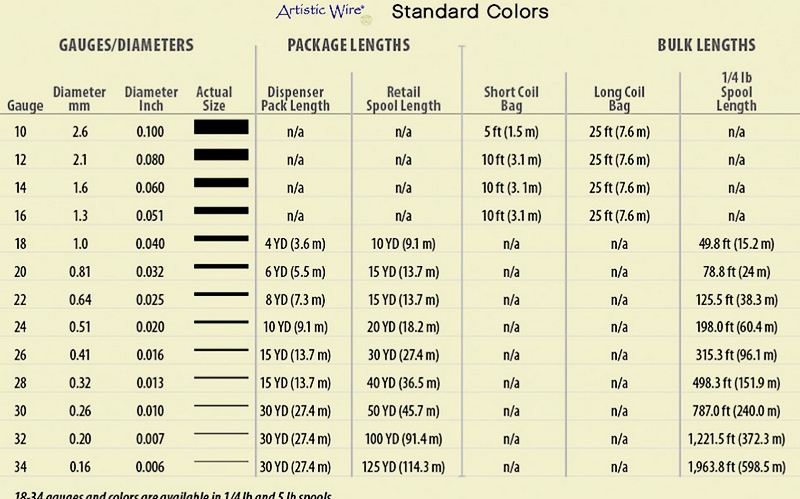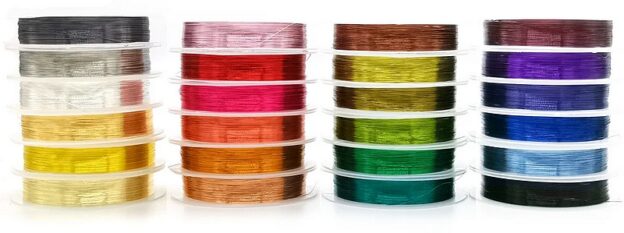I spent more hours trying to find “gold” than anything else, and gold being the, “..first or second most popular wire” in fly tying, I knew I had to return victorious versus carried on my shield. In hindsight, I’m thinking there may be an electronic convention that only certain colors are used to wrap electric motors, and that’s why some colors are easy to find and some not at all. Not being an electrician I can only guess that color and use are tied together when describing magnet wire, as certain colors are simply not available, hence the countless hours of my searching,
“Magnet wire” is the electrical name for the colored fly tying wire sold in fly tying stores. The enamel coloring of the wire also acts as an insulator. allowing it to be wound around a core to produce a magnetic field. Magnet wire is available in a huge range of sizes; in spools weighing from five pounds to as small as the three yard spools sold in fly shops. Magnet wire is available in only a few colors however, natural copper, amber (similar to natural copper), red, green, and blue. Searching electrical supply houses will not yield colors like gold, silver, black, and olive, or any of the other colors available to fly tiers, I assume its electrical use is somehow tied to specific colors.
Us anglers know identical wire is available in nearly thirty other colors and it’s likely the same manufacturer that makes them all, so why are some colors hard to find compared to red, green, and natural, colors that are available everywhere?
After countless hours of searching and several dozen manufacturers, the answer is simple. The wire is made by the large wire makers, but the colors are marketed to different customers. The electrical trade uses a finite grouping of colors, and all others are marketed to the “craft” industry.
If you require larger spools of enameled copper wire in other colors, specifically Gold, you need to use the search criteria, “craft wire” not “magnet wire.”
The problem with “craft wire” is that most of it is used for beading and jewelry work, so the sizes available are tied to strength, not necessarily its ampere rating. The wire sizes fly tiers use most commonly are 34 (34AWG) and 36 (36AWG) gauge. As the gauge number increases, the wire gets smaller, so 36 gauge would be for (roughly) size 14-16-18 hooks, and 34 gauge would be for 10-12-14 hooks. 32 gauge wire can be really useful on large flies, big stoneflies or steelhead flies, but isn’t sold in fly shops, only in electrical or craft venues.
Brass wire is “gold colored” and is much stronger than copper, and is used extensively in the jewelry business, so is an option for both fly tying and jewelry. It is tougher and stiffer than copper, so requires good scissors to cut it cleanly. Many types and sizes of brass wire exist in the jewelry business, but fly tiers should avoid all but the smallest sizes, 32, 34, and 36AWG. In addition to using your heavy scissors on brass, you need to ensure it is enameled with a clear coat, as brass can discolor with age. (Most jewelry grade brass wire is properly sealed, but the occasional off-shore vendor may not coat their wire).
Stainless steel wire is also commonly available as a “silver colored” wire. If you have a quality set of heavy scissors it is a wonderful, tarnish proof, version of a silver wire, but don’t use good scissors to cut it, you will destroy them over time. Excellent for salt water flies, used in 32 AWG.
Your biggest wire use will be natural copper and gold. The first is easy to find, and the second, gold, is very difficult to find as it is the craft variant. Internet search engines are NOT your friend, as searching for “gold wire” or “silver wire” will return gold (or silver) plated, or gold (or silver) filled wire, “Gold colored wire” made of copper will not even make the first couple of pages of the search result. Search engines will return, in order; real gold wire, gold plated, gold filled wire, brass wire, and then other wire types, like gold colored copper or aluminum wire.
As craft wire is intended for jewelry, real gold and real silver are more commonly used than all other wire colors and types, and dominate all search results from Google or similar search engines. AI based searching is a little better, but AI searches (using CoPilot or similar) are not yet smart enough to distinguish between real gold and gold colored, so you have to select your search terms carefully.
Many craft oriented vendors exist but few accomodate our need for the smallest craft wire sizes, and most only carry craft wire to 30AWG, which is much too thick for fly tying, and not terribly strong for jewelry. Finding a consistent source of gold or silver colored craft wire is problematic.

Artistic Wire is a vendor of many different colors of colored copper wire. They offer nearly 30 colors of copper wire, and brass wire, but only down to 34AWG. The above chart shows that a 1/4lb spool of 34 gauge wire contains about 2000 ft of wire, and retails for around $12-$15 dollars. Considering that a fly shop sells the same wire for $4 for 15 feet, and you can see the savings.
Only Gold and Copper wire are used in quantities warranting the purchase of larger spools, but some tiers may have unique needs. Local flies like Olive or Brown Copper John nymphs, or steelhead flies tied with woven copper bodies may require larger quantities of wire on hand.
The best source of craft related materials, and wire, is the ETSY website. Etsy is similar to Ebay in that it is a market of individual vendors, stores, and hobbyists, and sells nearly everything needed for craft making. Like Ebay, Etsy vendors can be long or short lived, so buying small amounts may require different vendors for every sale. I tend to buy the 1/4 lb spools, which ensures that I need only make one purchase per lifetime
Etsy’s search interface is mind numbingly long, and is not very helpful in the results it returns, due to its use of “popular” results versus what you actually asked for … Searching for a specific color may be onorous due to your inability to get more precise in Etsy search. Etsy does have most of the colors and sizes of wire we’re accustomed to seeing at the fly shop, and it has considerably more sizes, most of which are not useful however.
Ebay also features craft wire and overruns of products sold at a discount. Each tier’s unique needs will determine which vendor or source suits them best, but remember to check the gauge to ensure you’re getting the right size as well as color.
Rules for Buying Wire on the Internet
- Always buy copper wire from an electrical source. “Natural” colored copper wire is the easiest and cheapest wire you can find. Craft sources sell it for two or three times what the electrical sources sell it for, so select your copper wire using the search criteria, “Magnet Wire” which will only return electrical vendors.
- Buy your Gold (colored) wire via the search term, “Craft Wire”. Gold colored wire is easy to find on Etsy or Ebay using the craft designation in your search.
- When buying either, ALWAYS double check the gauge you are buying. With simple enamelling, 34 Gauge wire is typically, decimal 0.016, and 32 Gauge is typically, 0.020, if the vendor only supplies the decimal sizes, use this as a reference to what you’re seeing.
- Trout sizes of wire are 34 or 36 gauge, large nymph and steelhead, 32 gauge.
Searching for fly tying wire can be especially rewarding when you need colors not stocked by your local fly shop. Many of the jewelry uses require imitations of the different types of gold, yellow, rose, or red gold, and additional colors are available due to the jewelry usage. Most fly shops don’t stock a huge selection of wire, but you can find nearly every color you need on the Internet. Etsy features color assortments from some vendors
Remember that nothing is made expressly for fly tying. The number of fly tiers is too small an audience to command unique products from the huge metallurgy vendors that make wire for real industry. Ultra wire is simply wire, there is nothing special about it, nor is there any unique properties that make it especially good for fly tying, other than its gauge and color.
In summary: Fly tiers have a huge range of sizes available in red, green, amber, and natural copper colors, and have less selection of sizes in nearly every other color. Beading and jewelry requires heavier wire than we use, so typically the smallest sizes for craft wire are in the larger ranges of fly tying wire, 32-34 gauge. (32-34 AWG)
Recommendation
Buy 1/4 or 1/2 lb spools of only GOLD and COPPER colored wires, in 34 or 36 gauge wire. I would buy both if cost is not an issue. These larger spools change with the price of copper, currently around $14 to $20 per spool.
Buy 34 gauge if your nymphs trend to the larger sizes (12 or larger), and 36 gauge if you tie mostly smaller sizes (14 and smaller). Please note that you can use the smaller, 36AWG on any fly size – I’m assuming that 34 gauge is identical to Ultra wire, so choose accordingly.
These represent the lion’s share of all fly tying uses, and will be the spools you reach for time and time again. The rest of the colors are optional – although the gloss black wire. and coffee brown wire did catch my eye … I’m still puzzling over whether to get the five pound spool on those …

